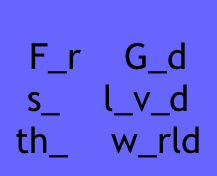 | |
 | |||
Phonics Basics Phonics teaches the 71 basic letters and letter combinations (phonograms) needed to pronounce the 44 sounds of the English language. A well-designed phonics program also teaches the most common spelling, pronunciation, and syllable division rules needed to figure out which sound to use when. (There are approximately 50 basic rules.) The consonant sounds are remarkably constant. Even those that change, like c as "k" or "s" and g as "g" or "j," conform to simple rules. The vowels are the only letters that vary, and there are simple rules to figure out which sound a vowel makes. However, even in the absence of these rules, you can figure out most sentences based entirely on the consonants. Try to read the following: | |||
 | ||
Phonics is actually quite simple, and was taught successfully by mostly young teachers in the days of one-room schoolhouses. Phonics has fallen in favor in the last 50 years, but is beginning to make a comeback. No Child Left Behind (NCLB) mandates proven reading instruction (phonics is the only scientifically proven reading method) and requires testing to make sure children are reading at grade level. Phonics. It works. It's proven. (See the evidence here and at the National Right to Read Foundation, NRRF) To see the benefits of phonics for yourself, watch 40L's phonics lessons online or, for a young beginner, the free lessons at Starfall.com. You can also find well designed phonics programs on Don Potter's education page or at the NRRF. | |